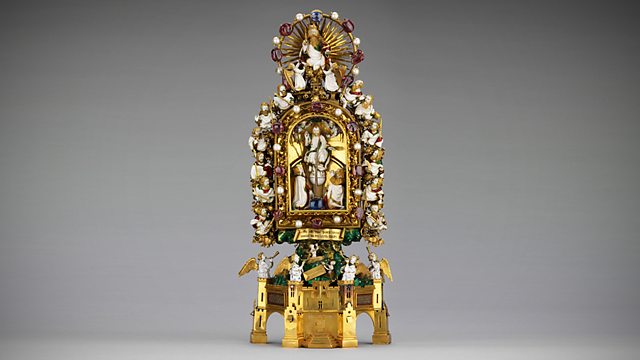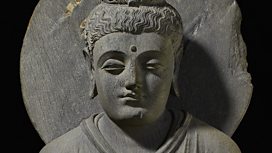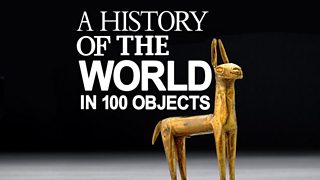Holy Thorn Reliquary
Neil MacGregor's world history explores ways of expressing the divine in the 14th and 15th centuries. Today - a famous Christian reliquary made to house a sacred thorn.
Neil MacGregor's world history as told through things. This week he is exploring the sophisticated ways that people expressed religious yearning in the 14th and 15th centuries. He is looking at the statues of gods and ancestors - in India, Mexico and on Easter Island - and he describes the importance of icon painting in the Orthodox Church.
Today he is with an object designed to connect with Christ himself - a stunning Christian reliquary from medieval Europe made to house a thorn from the crown of thorns. Neil tells the story of this highly ornate reliquary while Sister Benedicta Ward and the Archbishop of Leeds, the Right Reverend Arthur Roche, help explain the background and meaning to the powerful tradition of relic worship.
Producer: Anthony Denselow
Last on
More episodes
Previous
You are at the first episode
![]()
Discover more programmes from A History of the World in 100 Objects about religion
About this object
Location: Paris, France
Culture: Middle Ages
Period: 1400 - 10
Material: Metal
��
The Crown of Thorns, worn by Jesus when he was mocked and crucified, was one of the great relics of medieval Christianity. It was acquired by Louis IX, king of France, in Constantinople in AD 1239 for the price of 135,000 livres - nearly half the annual expenditure of France. Jean, duc de Berry (1340-1416) commissioned this elaborate reliquary to house just one of the thorns, which is mounted on a large sapphire in the centre.
How were relics used in medieval Europe?
Christian relics were usually part of the physical remains of a saint, though they could also be associated objects or clothing. Medieval worshippers would contemplate relics as a means of getting closer to a saint or Christ himself. Relics were also associated with miraculous powers of healing. Pilgrims would travel hundreds of miles to visit important relics in shrines, such as Jerusalem or Canterbury. Trade in holy relics was a huge business in Medieval Europe and kings would assemble large collections and even go to war to secure them.
Did you know?
- The Crown of Thorns acquired by Louis IX is now housed in Notre Dame Cathedral in a container provided by Napoleon.
Approaching the divine
By Robert Maniura, Department of History of Art and Screen Media, Birkbeck, University of London
��
In the context of faith, what the thorn reliquary displays is almost unimaginably valuable and emotive: something that is meant not only to have touched Christ – the viewer's Saviour – but also to have been involved in his torture during his Passion.
Christ suffered and died for the sins of all mankind, according to the Christian faith, and the viewer's sins therefore contribute to that suffering. The viewer is brought face to face with the humbling implications of his or her life. And yet the relic is just a little stick. In visual terms it is profoundly disappointing. Its real appeal is tactile.
What the believer wants is to touch - touch the thorn that pierced Christ's flesh. But the thorn is sealed away behind its crystal screen. The reliquary is a display cabinet. The British Museum's display of the reliquary reproduces the same device on another level: you can see but not touch.
The reliquary is in the end somewhat coy: it presents the priceless thorn but holds the viewer back from a satisfying engagement with it. In compensation the reliquary gives the frustrated viewer something to look at. It visualizes the significance of the relic in its display of Christ and points beyond the suffering to the hope of Salvation in its depiction of the heavenly host.
The display case itself becomes an object of contemplation. But what do we end up contemplating? The reliquary's materials are in themselves valuable and its craftsmanship is of a high order. One can rationalize this as honouring the holy contents. But the Duke who owned the reliquary was a notable collector of luxury objects. Many were at least nominally placed in the service of the faith but we may be seeing a transition to a more familiar sort of collecting of precious objects for their own sakes.
Visitors to the British Museum come to admire the container and not reverence the thorn, but one suspects that there may have been at least some ambivalence in the Duke's own view.
Transcript
Broadcasts
- Mon 5 Jul 2010 09:45�鶹������ҳ��� Radio 4 FM
- Mon 5 Jul 2010 19:45�鶹������ҳ��� Radio 4
- Tue 6 Jul 2010 00:30�鶹������ҳ��� Radio 4
- Mon 12 Jul 2021 13:45�鶹������ҳ��� Radio 4
Featured in...
![]()
Religion—A History of the World in 100 Objects
A History of the World in 100 Objects - objects related to religion.
![]()
Leaders and Government—A History of the World in 100 Objects
More programmes from A History of the World in 100 Objects related to leaders & government
Podcast
-
![]()
A History of the World in 100 Objects
Director of the British Museum, Neil MacGregor, retells humanity's history through objects





